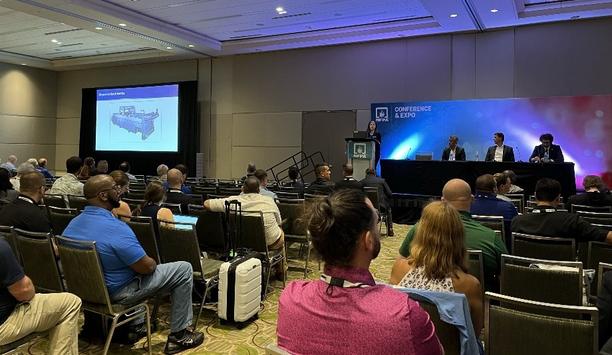Chemicals broadly labeled as PFAs provide important properties to turnout gear used by firefighters, including better resistance to heat, water, and other hazards. Unfortunately, human exposure to per- and poly-fluoroalkyl substances (PFAs) has also been linked to heightened cancer risk.
Research on the concentration of PFAs
The U.S. National Defense Authorization Act of 2021 directed the National Institute of Standards and Technology (NIST) to identify the prevalence and concentration of PFAs in the personal protective equipment worn by firefighters.
The resulting research has identified the presence of PFAs in 20 textiles used to make the various layers of a firefighter’s turnout gear.
PFAs
The water- and oil-resistant properties of PFAs have made them ubiquitous components in products
The water- and oil-resistant properties of PFAs have made them ubiquitous components in manufactured products, including textiles used in firefighter apparel.
PFAs have found their way into the bodies of most Americans, and research has shown higher PFA concentrations in the blood among firefighters. However, there are numerous potential pathways to exposure, including fire scenes, aqueous film-forming foams, food grown at fire stations, ambient dust, as well as firefighter turnout gear.
Health effects
The health effects of PFA exposure are the subject of extensive ongoing research. For example, cancer incidence data are available for only a subset of known PFAs. PFAs do not break down easily and persist in the human body and the environment, thus earning the name “forever chemicals.”
Further research continues what kinds and levels of PFAs are dangerous and how the chemicals find their way into the body.
Presence in turnout gears
PSAs potentially could be present in any one of the three layers of turnout gear, the outer shell, the moisture barrier, and the thermal liner.
All three layers must conform to National Fire Protection Association (NFPA) requirements to resist heat, water, and other hazards.
Research findings
NIST researchers targeted 53 PFAs used to fabricate 20 textiles used in various layers of turnout gear
NIST researchers targeted 53 PFAs used to fabricate 20 textiles used in various layers of turnout gear. They identified and quantified concentrations of 26 different PFAs.
Researchers found the least amount of PFAs in the fabric layer closest to a firefighter’s skin, the thermal lining; water repellency is a lower priority for this layer than the other two. In contrast, the moisture barrier and the outer shell contained PFA concentrations up to 400 times higher, although the numbers varied from fabric to fabric.
update turnout equipment standards
Changing to a non-PFA water-repellant coating on the outer layer could essentially eliminate PFAs from that layer. Since the thermal liner already has low PFA content, that leaves only the moisture barrier layer to address. However, researchers caution about the possibility of swapping one risk for another.
Information gleaned from NIST research could be used to update turnout equipment standards and give firefighters more confidence in the safety of the equipment.
wear and tear
Another factor to consider is the impact of wear and tear on how many PFAs escape from turnout gear. Factors include UV exposure, heat, and laundering, which have a measurable impact on PFAs in turnout gear.
NIST efforts currently underway will use high-resolution mass spectrometry to identify a broader swath of PFAs than the 53 compounds already quantified, including screening for previously identified compounds as well as searching for novel PFAs.
PFA exposure
Future research will study fire scenes, fire stations, and other occupational environments where firefighters work in
Future work will also evaluate the type and amount of PFAs released from firefighter gear textiles upon exposure to simulated sweat.
Other routes to PFA exposure among firefighters are also being targeted by NIST research, including hoods, gloves, and wildland gear. Additionally, future research will study fire scenes, fire stations, and other occupational environments that firefighters' work in.
Risk of cancer
Firefighting is a dangerous profession, and firefighters are at higher risk of a variety of cancers compared to the general population. According to the National Institute for Occupational Safety and Health (NIOSH), cancer is a leading cause of death among firefighters.
Firefighters face a 9 percent increase in cancer diagnoses, and a 14 percent increase in cancer-related deaths, compared to the general population in the U.S.
Exposure to toxic combustion products
How the exposure of PFAs ranks among those risks is debatable.
Firefighters can be exposed to many known and suspected carcinogens through their work
Firefighters can be exposed to many known and suspected carcinogens through their work. All types of fires create a mixture of toxic combustion products including liquids, gases, and particulate matter. Firefighter protective equipment containing suspected carcinogens is just part of the bigger picture.
adverse health risks
In August 2022, the International Association of Fire Fighters and the Metropolitan Fire Chiefs Association joined forces to alert members to the adverse health risks posed by PFAs in turnout gear, to draw attention to the need for PFAs-free turnout gear, and to recommend precautionary steps for members and departments until next-generation gear can be developed and put in use.
In January 2023, the IAFF announced it had retained three nationally recognized tort law firms to assist the union in its effort to end firefighter cancer and remove PFAs from use in the fire service.




































